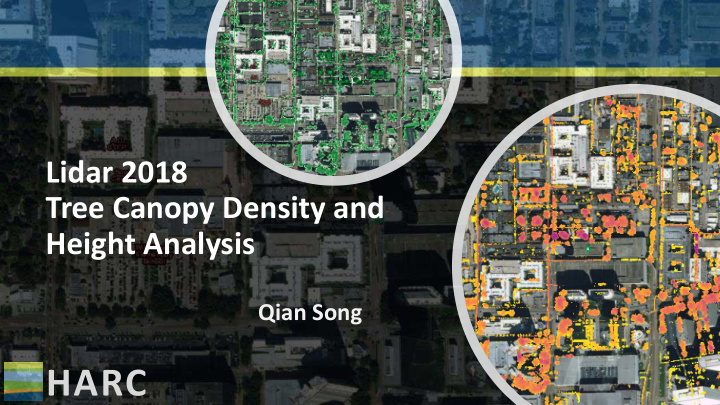



Lidar 2018 Tree Canopy Density and Height Analysis Qian Song HARC
LAS Point Classification 1 Processed, but unclassified 2 Bare-earth Ground 3 Low Vegetation (0.01m to 1.00m) 4 Medium Vegetation (1.01m to 3.00m) 5 High Vegetation (greater than 3.01m) 6 Building 7 Low Point (noise) 9 Water 10 Ignored Ground Data: 2014 TCEQ 14 Culverts 17 Bridge Decks Image: https://environment.arlingtonva.us
Tree Canopy Density
Tree Density - Methodology 1. Divide the study area into many small equal-sized units (Raster Dataset) 2. In each raster cell, Density = The Number of Above Ground Points The Total Number of Points The Number of High Vegetation Points Tree Canopy Density = The Number of High Vegetation Points + The Ground Points
Tree Density - Workflow Las Dataset Layer (Above Ground) Above Ground Points Raster Tree Canopy Las Point Statistics As Las Dataset Divide Density Raster Raster (Point Count) Total Points Las Dataset Layer Raster (Total) Tips Convert any resulting NoData cells to 0 • Make sure one raster to be floating point to get floating-point output •
Tree Density - Results
Tree Density - Results
Tree Canopy Height
Tree Height - Methodology Digital Surface Model(DSM): the first return surface First return of the High Vegetation Class Digital Elevation Model(DEM): the bare earth surface Canopy Height = DSM - DEM
Tree Height - Workflow Las Dataset Las Dataset Layer (Above Ground & Las Dataset to Raster DSM First Return) Minus Tree Height DEM
Tree Height - Results
Tree Height - Results
Houston Advanced Research Center (HARC)
Wrap Up • Tree Canopy Density and Height Processes and Results • Other applications – Flood Inundation Depth and Area
Qian Song qsong@harcresearch.org HARCresearch.org 281-364-6085 HARC (härk), n. an independent research hub helping people thrive and nature flourish.
Recommend
More recommend